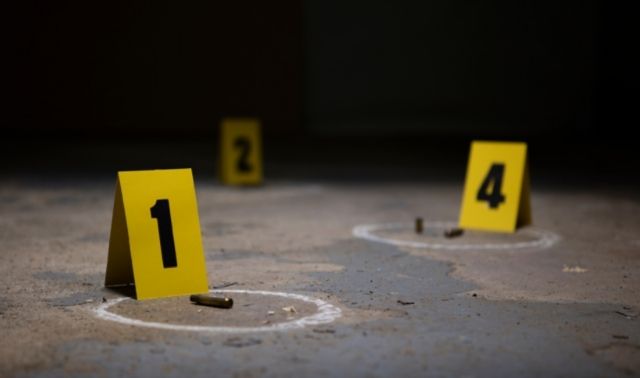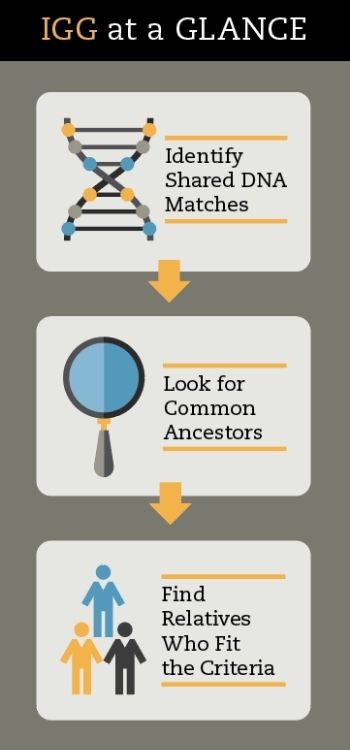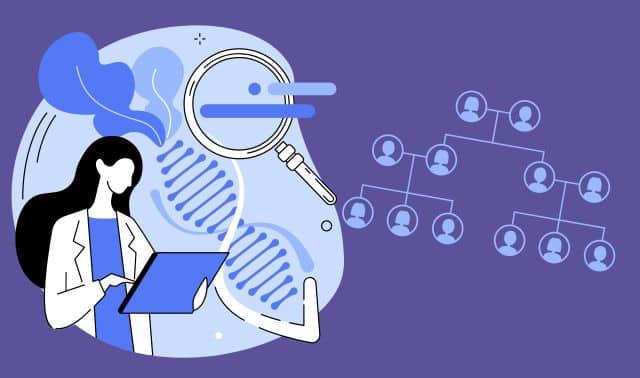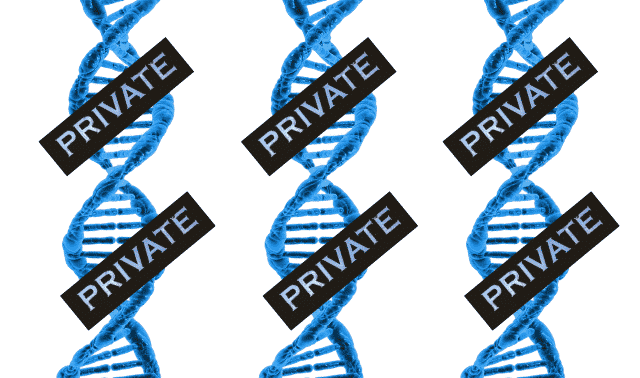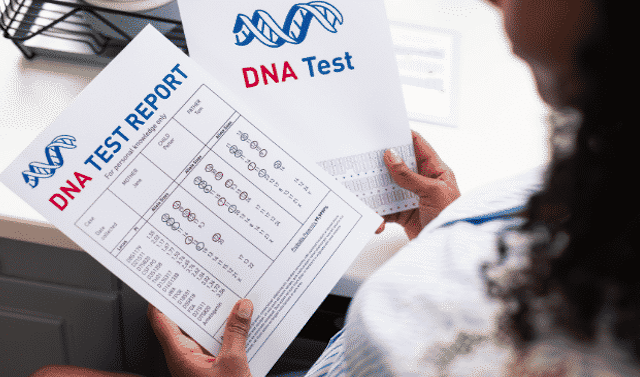Content warning: This article contains references to rape, sexual violence and murder. Reader discretion is advised.
The “Golden State Killer,” who was responsible for at least 13 murders and 45 rapes throughout California in the 1970s and 1980s, eluded law enforcement for decades. But in 2017, investigators tried to reopen the case. They extracted the suspect’s DNA profile from a rape kit and uploaded it to GEDmatch, which pools results from various genealogy DNA tests.
DNA matches to the kit led investigators to possible relatives of the suspect. Using genealogy research, they built out a family tree, then looked for suspects who had the right DNA profile. Two months later, they had a shortlist of names. And in April 2018, police arrested Joseph DeAngelo, who would plead guilty to multiple counts of rape and murder, and be sentenced to life in prison. In just a few months, DNA was able to solve cases that had stumped law enforcement for nearly 50 years.
The powerful methodology used in the Golden State Killer case has evolved into a new field: investigative genetic genealogy (IGG). The FBI reports more than 250,000 murders have gone unsolved since the 1960s, with another 6,000 added every year. IGG is helping to solve that backlog by combining genetic analysis with genealogical research.
But what does it mean for DNA test takers and their relatives? And how does DNA testing help solve crimes? Read on to learn about investigative genetic genealogy: how it works, what major companies are doing in response, and why it’s sparking some controversy in the genealogical community.
How DNA Tests Solve Crimes
First, the assailant’s DNA is collected from crime-scene evidence. That DNA profile is converted to a format that can be anonymously uploaded to GEDmatch or Family Tree DNA, the only two major consumer genetic genealogy databases that explicitly permit law enforcement use.
Once the database processes the sample, it produces a list of matches to the perpetrator’s DNA. Those matches could be close family members or distant relatives, such as fourth cousins. The more DNA the two profiles share, the more closely the match is probably related to the perpetrator.
Then, genealogists build family trees for the matches using various traditional sources, such as birth certificates, obituaries, wedding announcements and public records. They work backward in time, with a goal of finding common ancestors in the matches’ family trees. Then they work forward in time, identifying those ancestors’ descendants as well as marriages. Each DNA match helps narrow down the list.
Once promising candidates have been identified, law enforcement might collect a discarded DNA sample from them (such as a used napkin or cigarette) and compare it to the crime-scene DNA. That analysis either confirms or disproves the match.
That’s what happened in the pioneering Golden State Killer case. None of the initial GEDmatch matches were close relatives to the suspect. But genealogist Barbara Rae-Venter and five other investigators took on the case, focusing on profiles that seemed to be the suspect’s distant cousins.
Using traditional genealogy methods, they identified a set of shared great-great-great-grandparents, then followed the family line down to the suspect’s era. After weeding out suspects based on factors like age, physical characteristics, and location, Rae-Venter had DeAngelo’s name. He was arrested after being identified as the killer based on DNA found in his trash can and on his car’s door handle.
In just a few months, DNA was able to solve cases that had stumped law enforcement for nearly 50 years.
DNA analysis itself is not a new tool for US law enforcement, which has its own DNA database known as the Combined DNA Index System (CODIS). CODIS contains DNA profiles of people convicted (and, in some cases, arrested) for crimes, as well as of missing persons and unidentified human remains.
But not everyone convicted of a crime is in the CODIS database (laws vary by state and type of crime), and CODIS wouldn’t include those outside of the criminal justice system. By using consumer genetic genealogy databases, law enforcement can greatly enlarge the pool of potential matches that might lead to an assailant.
What Cases Have Been Solved Using Investigative Genetic Genealogy
Since it was used to identify the Golden State Killer in 2018, investigative genetic genealogy has been successfully employed to crack hundreds of cold cases.
Identifying human remains
Deputies found the body of a young woman near a makeshift campsite in Colorado’s Pike and San Isabel National Forest in 1993. Close examination of the crime scene and tools like facial reconstruction failed to identify her or determine the circumstances of her death.
The case was cold until 2020, when the Douglas County sheriff’s office identified the deceased as Rebecca Ann Redeker. The office had used DNA evidence in conjunction with United Data Connect, Inc., a company that specializes in genetic genealogy and cold cases. Initially, investigators thought the victim was a runaway. But thanks to DNA, the investigation has been given new legs.
Identifying foundlings and kidnapping victims
Two days after Chester and Dora Fronczak’s son Paul was born in a Chicago hospital in 1964, a woman dressed as a nurse kidnapped the baby. That set off a worldwide manhunt. Fifteen months later, a toddler with a black eye was found abandoned in his stroller in Newark, N.J. When Dora saw the boy, she immediately claimed he was hers and took him home.
But Paul didn’t look like his parents, and a DNA test in 2012 proved he could not be their child. Genetic genealogist CeCe Moore and her team of DNA experts took on the case. Autosomal DNA, Y-DNA, mitochondrial DNA and X-chromosome DNA analysis, as well as extensive genealogical research, proved that “Paul Fronczak” was born Jack Rosenthal from Atlantic City, N.J. The toddler had been reunited with the wrong family; the “real” Paul Fronczak was raised by another family as Kevin Baty.
Solving cold-case murders
In 1987, Jay Cook and Tanya Van Cuylenborg, a young couple from British Columbia, disappeared after taking a ferry from Vancouver to Seattle. Their bodies were later found miles apart, both brutally murdered. Police collected evidence, including the killer’s DNA. But with few clues, the case remained cold for 30 years.
But in 2018, CeCe Moore, the “Miss Marple of Genealogy,” took on the case. Like the famous Agatha Christie character, Moore can find critical clues in murder cases that others can’t. After spending just two hours on a Saturday, she identified a suspect, William Earl Talbott II, a truck driver who lived not far from where Cook’s body was found. Snohomish County law enforcement had spent three decades accumulating a voluminous case file, but Talbott’s name had eluded them.
Moore, now the Chief Genetic Genealogist for Parabon Nanolabs, heads a genetic genealogy law-enforcement unit that includes three other genetic genealogists. By her estimate, her firm has solved more than 400 cases, including 200 criminal cases and dozens of unidentified remains, using crime-scene DNA and constructed family trees. An ABC documentary series, “The Genetic Detective,” follows Moore as she uses investigative genetic genealogy to solve cold cases. (You can watch online).
Concerns About DNA and Crime-Solving
The Golden State Killer’s arrest set off a wave of discussion about genetic genealogy, privacy and law enforcement.
In an attempt to balance public safety with privacy concerns, the U.S. Department of Justice released guidelines in 2019 on how federal investigators and federally funded investigations could use genetic genealogy to track down suspects. The policy states the use of forensic genetic genealogy should be limited to solving violent crimes (such as murder and rape) and identifying human remains. Broader use is permitted if the DNA database’s policy allows such searches.
Blaine Bettinger, “The Genetic Genealogist” and author of The Family Tree Guide to DNA Testing and Genetic Genealogy (Family Tree Books), finds the policy insufficient. “The DOJ guidelines are a good start, but it’s not clear to what extent they’ll apply to most labs—especially commercial labs—and there’s no clear penalty for violating the rules,” he says. “This requires very careful oversight to ensure as minimal an invasion of privacy as possible.”
Some states have taken matters into their own hands, implementing various policies:
- Maryland limits IGG to crimes like murder and kidnapping and requires a judge’s authorization to use this technique.
- Montana law enforcement need a warrant to use genetic DNA databases, unless the users waive their right to privacy.
- In contrast, Florida is actively taking advantage of IGG to solve cold cases. The Florida Department of Law Enforcement set up a Genetic Genealogy Program in 2018.
Despite governmental measures, some genealogists are uncomfortable with DNA data being used by law enforcement. Here are some common concerns, and whether or not they are based in fact:
“My DNA might implicate one of my relatives in a crime”
This is true. In fact, details might come to light about your relatives if you consent to DNA matching on any testing site, whether or not the site allows law-enforcement matching. For example, your DNA could be used to identify a birth parent who wishes to remain anonymous. Your relatives are routinely impacted by your own test results, but rarely (if ever) give consent for you to take a test.
For some, the potential consequences of DNA and crime-solving are severe enough to give pause. “When we are hunting for ancestors and even bio[logical] parents, these discoveries can have long-lasting ramifications in families,” says Diahan Southard, author of Your DNA Guide (self-published) and its related website. “But putting someone in jail, or possibly causing their death by the death penalty, deserved or not, takes that to a new level.”
“A DNA match could result in a false arrest or conviction”
The kind of DNA matching used for law enforcement is highly accurate. The rare exceptions that could result in a “mistaken identity” arrest are cases in which the match is actually the offender’s identical twin, or a stem-cell or bone-marrow transplant took place.
As a matter of fact, DNA evidence is being used to exonerate the wrongly convicted. The Innocence Project through the Cardozo School of Law at Yeshiva University has documented 375 DNA exonerations in the United States between 1989 and January 2020. Of them, 21 former convicts had been sentenced to death.
In addition, law enforcement only uses a suspect’s DNA matches as a starting point. Before making an arrest or pursuing charges, they also look for corroborating evidence from more traditional sources, such as a weapon or eyewitness accounts. This is part of the Department of Justice’s forensic genealogy guidelines.
“Innocent people’s DNA will also be collected”
This happens anyway. All DNA at a crime scene is investigated, even among people ultimately cleared of suspicion.
How DNA Companies Respond to Law Enforcement
Law enforcement bears the brunt of responsibility in using DNA tests for IGG, but the testing companies themselves also play a role. What follows are the policies set out by some of the major players in consumer DNA testing.
GEDmatch
GEDmatch doesn’t do DNA testing itself. However, it’s become a free, popular destination for genetic genealogists who have tested with other services. Test takers from AncestryDNA, 23andMe and other companies can upload their DNA results to GEDmatch and get matches with relatives who might have tested at a different company. Despite that “third-party” status, GEDmatch has been directly in the forensic genealogy spotlight.
Following media coverage of GEDmatch’s role in the Golden State Killer case in April 2018, the number of people uploading their DNA to GEDmatch shot up from 1,500 per day to 5,000 per day. Partially as a result, GEDmatch became the primary genetic DNA database for law enforcement.
In May 2018, GEDmatch updated its policy to allow law enforcement to use the database to identify perpetrators of violent crimes, specifically homicides or sexual assaults. Less than a year later, GEDmatch allowed law enforcement to use its database for a case that didn’t fall into that category, violating its terms of service.
Once that decision became public, the resulting outcry led GEDmatch to again change its policy in May 2019. All users were opted out of law-enforcement matching; they had to manually opt in to be included. The number of kits available for that purpose immediately dropped from hundreds of thousands to none. Some users have since opted back in, and (according to Brett Williams, the CEO of GEDmatch’s parent company) about 75 to 80% of new users opt in. Authorized organizations may still use any GEDmatch data to identify human remains, regardless of opt-in status.
Also in May 2019, GEDmatch modified its definition of violent crimes to conform to the FBI’s use of the term. Law enforcement can now use the GEDmatch database to investigate not just homicide and sexual assault, but also other crimes, including robbery and aggravated assault.
To opt in or out of law enforcement matching, log on to GEDmatch and scroll down to the list of your kits under Your DNA Resources. A red X over the POLICE icon next to a kit indicates the kit is opted out. If there’s no red X, the kit is opted in. Click on the icon to change its status.
Linking a GEDCOM file that has your family tree to your DNA profile on GEDmatch enables DNA matches to see how you might be related to them, and it helps law enforcement search for a perpetrator. You can create a GEDCOM file from genealogy software or an online family tree, such as an Ancestry Member Tree.
In late 2019, Verogen, a genetic sequencing company, acquired GEDmatch. The company focuses on forensic science, and it has a separate website (GEDmatch PRO) accessible only to law enforcement.
Family Tree DNA
In 2018, Family Tree DNA adopted a policy allowing law enforcement to participate in its database to identify violent criminals (perpetrators of homicide, sexual assault or child abduction) and human remains. That makes Family Tree DNA the only major consumer DNA testing company to allow such access. In fact, the company ran advertisements encouraging users to upload in order to solve long-cold cases and bring closure to victims’ families. (Editor’s note: Though one of the magazine’s advertising partners, Family Tree DNA is a separate entity from Family Tree Magazine.)
All US Family Tree DNA users are opted in to law-enforcement matching by default. (That’s the opposite of GEDmatch’s current policy, which opts everyone out by default.) To opt out, log into your account and click on your name in the upper right corner of the screen. Go to Account Settings > Privacy & Sharing. Then drag the “On” button by Law Enforcement Matching to “Off.”
Other Companies
The other major consumer DNA testing companies (23andMe, AncestryDNA, Living DNA and MyHeritage DNA) allow law-enforcement matching in their databases only in response to a court order, a subpoena or a search warrant. Those requests are rare.
Forensic genealogy is proving to be a powerful tool for law enforcement, but not without some controversy. Test takers can take solace in knowing that, under DNA testing companies’ terms of service, their data can only be used by investigators in certain circumstances.
Here are some ways you can be proactive when it comes to your DNA:
- Read a site’s terms of service before you test or upload. Keep up to date on these policies, as they may change over time.
- Decide whether to opt in or out of law-enforcement matching. At time of writing, GEDmatch opts users out by default, whereas Family Tree DNA opts users in. (The other services only comply with law enforcement if ordered by a court.)
- Get involved with policy-making. Pay attention to laws being considered by your local governments and Congress, and put pressure on elected officials to make it harder (or easier) to use commercial DNA databases for law enforcement.
Case Study: Solving an Ancestor Paternity Question with DNA
You can use the same investigative genetic genealogy process in your own research. Here’s an example from my own family, in which I use IGG methods to determine how I’m related to a DNA match.
My father has a match named Patrick on both AncestryDNA and Family Tree DNA. Both services estimate that he and my dad are second or third cousins based on their shared DNA.
Patrick had no online family tree and I didn’t recognize his name, so I contacted him. He replied that he was an adoptee, and that his recently identified birth mother was born in Tahiti and lived in New Caledonia before moving to Australia. That’s where Patrick was born in December 1945.
My family didn’t seem to be related to Patrick’s birth mother, whose family came originally from France. So the connection had to be on the paternal side—Patrick’s unidentified birth father.
1. Identify shared DNA matches
I started by examining my dad and Patrick’s shared DNA matches. (All the major DNA-testing companies have tools to identify other matches you have in common with a particular DNA match.) The shared matches I recognized were on my dad’s maternal grandmother’s side of the family.
2. Look for common ancestors
I found that the shared matches’ most recent common ancestors were my dad’s great-great-grandparents William E. Pennington (1803–1884) and his wife Isabella (Slip) Pennington (1821–1898). They had at least 12 children, and Patrick was probably a descendant of one of them.
3. Find relatives who fit the criteria
Next, I looked through their descendants in search of candidates to be Patrick’s father, probably born between about 1900 and 1925. I found three—George H. (born in 1904), George Y. (born in 1906), and George D. (born in 1921). Like a criminal investigator, I needed to determine if one of those candidates lived in the area when the event (Patrick’s conception in early 1945, South Pacific) took place.
Given the time frame, I wondered if Patrick’s birth father might have been an American soldier stationed in Asia during World War II. I checked Ancestry’s collection, “U.S., World War II Army Enlistment Records, 1938–1946.” I found George D. there, but he enlisted for service in the Philippines in November 1945 (only a month before Patrick was born). That seemingly ruled him out.
Next, I turned to Newspapers.com in search of any mention of the Georges during World War II. I hit pay dirt with three articles in Oregon newspapers. An article from May 1943 said that George H. was “now in the armed forces and serving somewhere in the South Pacific.” It even had a picture of him. In February 1944, the newspaper reported that he was a major, “now stationed somewhere in New Caledonia.” And in November of that year, it says he was still on duty in the South Pacific, “according to word from New Caledonia.”
Those articles put him in the right place and time to have had a rendezvous with Patrick’s birth mother. DNA evidence, backed up with research in historical records, revealed George H. as the potential identify of Patrick’s father.
Related Reads
A version of this article appeared in the May/June 2022 issue of Family Tree Magazine.

